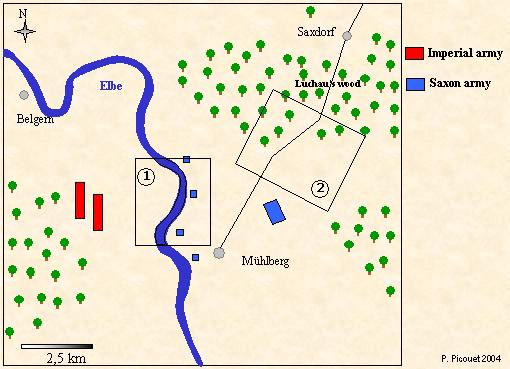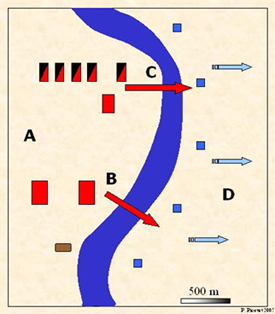| Saxon Army Commander: John Frederic of Saxony Infantry: 7 000 men Cavalry: 3 000 men Artillery : 21 guns Losses: 7000-8000 men |
Imperial army * Commander: Duke of Alba & Charles I Infantry ~ 13 000 men (Spanish Tercio : 7 800 men) Cavalry ~ 4 100 men Artillery: 20 guns Losses: 100 -200 men |
* note: some imperial unit are missing, probably on their way to the Elbe river
Strategic situation: In 1546, the
political and religious situation threat the position of the Emperor Charles
and degenerate in a war between the holy empire and the protestant princes
united in the Schmalkaldic league. After the useless campaign of 1546, Charles
V used the diversion provided by the entrance of Maurice of Saxony in Saxony
to attack one of the main partner of the league, the Elector of Saxony,
Johan Fredericks of Saxony. Johan Fredericks manage to repulse Maurice forces
but with a fast approach the Catholics take by surprise the unprepared John
Frederic of Saxony positioned behind the river Elbe near the city of Mühlberg.

Saxon Army: The elector of Saxony, John Frederic, couldn’t collect all his force in a camp located at the left of Mühlberg. He had some 7 000 foots divided in 17-18 companies and some 3 000 horses divided in 11 squadrons. A portion of the infantry (1000 men ?) was distributed along the river Elbe to detect the imperial army.
Imperial army: This army was commanded by the Imperator Charles V and his commander in chief in Germany the Duke of Alba. The bulk of the imperial army had 13 000 foots and some 4 050 horses, it was divided in 3 Spanish tercios (Tercio de Alvaro de Sande, Tercio de Nápoles and Tercio de Lombardia) with 7 800 foots, 2 German and Flemish regiments (Lazare de Schwendi and …..) with some 5 000 foots, a regiment of Hussars of 450 men, 900 light horsemen (Jinetes, Celadas and Archer à Cheval), 4 squadrons of men at arms (600 lances, 220 horses, 400 lances and 600 lances) commanded by Egmont van Buren, at last we have 3 squadrons of harquebusiers on horses with 900 men.
Phase 1: The Crossing of the Elbe River
Saxon Army: The elector of Saxony, John Frederic, couldn’t collect all his force in a camp located at the left of Mühlberg. He had some 7 000 foots divided in 17-18 companies and some 3 000 horses divided in 11 squadrons. A portion of the infantry (1000 men ?) was distributed along the river Elbe to detect the imperial army.
Imperial army: This army was commanded by the Imperator Charles V and his commander in chief in Germany the Duke of Alba. The bulk of the imperial army had 13 000 foots and some 4 050 horses, it was divided in 3 Spanish tercios (Tercio de Alvaro de Sande, Tercio de Nápoles and Tercio de Lombardia) with 7 800 foots, 2 German and Flemish regiments (Lazare de Schwendi and …..) with some 5 000 foots, a regiment of Hussars of 450 men, 900 light horsemen (Jinetes, Celadas and Archer à Cheval), 4 squadrons of men at arms (600 lances, 220 horses, 400 lances and 600 lances) commanded by Egmont van Buren, at last we have 3 squadrons of harquebusiers on horses with 900 men.
With a fast approach the bulk of the Imperial army arrived on the river Elbe the 23 of April. In a war council Charles decided to immediately the Saxon army before reinforcement could arrive.

|
A) Early the morning of the 24 of April a group
of 1000 Spanish harquebusiers and musketeers (some men were equipped with
the long musket) under the commanded of Rodrigo de Arce (MdC of the Tercio
of Lombardia) approach the south bank of the river and started to skirmish
with the Saxon pickets. The fact that the harquebusiers were inside their
legs in the water and long range of the musket give the fire superiority
for the Spanish. The Saxons resists some time before retiring from their
positions. B) With some boats collected along the river and captured by a detachment of Spanish swimming across the river, the imperial started to build a bridge to cross the river. C) Meantime, with the help of a discontent peasant, the imperial light cavalry find a short ford and Alba send quickly the 1 080 light horsemen supported by a detachment 450 harquebusiers. The Hussars cross the river with a harquebusiers on each horse and establish a strong bridgehead. Quickly, the rest of the cavalry supported by 1 000 Harquebusiers followed the hussars in crossing the river. D) Most of the Saxon pickets fled in panic, while John Frederic organised his army in a march formation and started to retreat to the road of Wittenberg. There was no intending to attack the weak Imperial bridgehead |
Phase 2: The battle
Seeing that his rearguard was press by the light imperial
cavalry, John Frederic took the decision to draw up his army in battle
formation with the infantry in the centre in two squadrons flanked by the
cavalry, 5 squadrons on the right and 4 on the left. 15 guns were positioned
in front of the infantry while the other 6 where retire to the rear. Charles
V organised the troops at his hand deploying on the right most of the
heavy cavalry (3 squadrons of men at arms and probably the 300 harquebusiers
on horses) under the Duck of Alba, and on the left flank the rest
of the cavalry (a small squadrons of men at arms, the harquebusiers on horse,
the Celadas and Jinetes companies) under Maurice of Saxony.
The light cavalry (hussars and the rest of harquebusiers on horse) was organised
in a single detachment to outflank the Saxons. The infantry was deployed
in the centre and organised as they arrived on the battlefield.

A) Commanded by Alba himself, the heavy cavalry of
the right wing charged the Saxons and routed them after a short fight.
B) On the left wing the harquebusier on horse supported by a squadron of lancers started to skirmish with the Saxon cavalry. The repeated fire from the Spanish horsemen destabilised the Saxon horses and after some minutes the Saxon cavalry begin to retire to find a proper cover.
C) In the centre the infantry stoop firm watching the arrival of the Spanish infantry and skirmishing with their vanguards.
D) Alba reorganised his cavalry and stated to attack the Saxon infantry left alone on the battlefield. On the left wing, the Spanish cavalry finished to defeat their opponent and started also to fire on the infantry.
E) Attacked by theirs flanks and by the infantry on the front, the Saxon infantry resisted for two hours before living in disorder the battle field.
F) The retreating troops were harassed by the Spanish cavalry and mostly destroy by the light Spanish cavalry and the hussars whose had outflanked the Saxons.
Balance:
The Saxons army was destroy, losing 2500-3000 dead, probably e 4 000 wounded and some 1000 prisoners. Two of the protestant leaders, the Elector of Saxony and the Duck of Brunswick, were among the prisoners. A week after the battle Charles V receive the submission of the main Saxon cities and the rest of the protestant princes will follow quickly, the Schmalkaldic war was over, but the protestant problem remain and will be settle 8 year later by the treaty of Augsburg.
B) On the left wing the harquebusier on horse supported by a squadron of lancers started to skirmish with the Saxon cavalry. The repeated fire from the Spanish horsemen destabilised the Saxon horses and after some minutes the Saxon cavalry begin to retire to find a proper cover.
C) In the centre the infantry stoop firm watching the arrival of the Spanish infantry and skirmishing with their vanguards.
D) Alba reorganised his cavalry and stated to attack the Saxon infantry left alone on the battlefield. On the left wing, the Spanish cavalry finished to defeat their opponent and started also to fire on the infantry.
E) Attacked by theirs flanks and by the infantry on the front, the Saxon infantry resisted for two hours before living in disorder the battle field.
F) The retreating troops were harassed by the Spanish cavalry and mostly destroy by the light Spanish cavalry and the hussars whose had outflanked the Saxons.
Balance:
The Saxons army was destroy, losing 2500-3000 dead, probably e 4 000 wounded and some 1000 prisoners. Two of the protestant leaders, the Elector of Saxony and the Duck of Brunswick, were among the prisoners. A week after the battle Charles V receive the submission of the main Saxon cities and the rest of the protestant princes will follow quickly, the Schmalkaldic war was over, but the protestant problem remain and will be settle 8 year later by the treaty of Augsburg.
Return
.